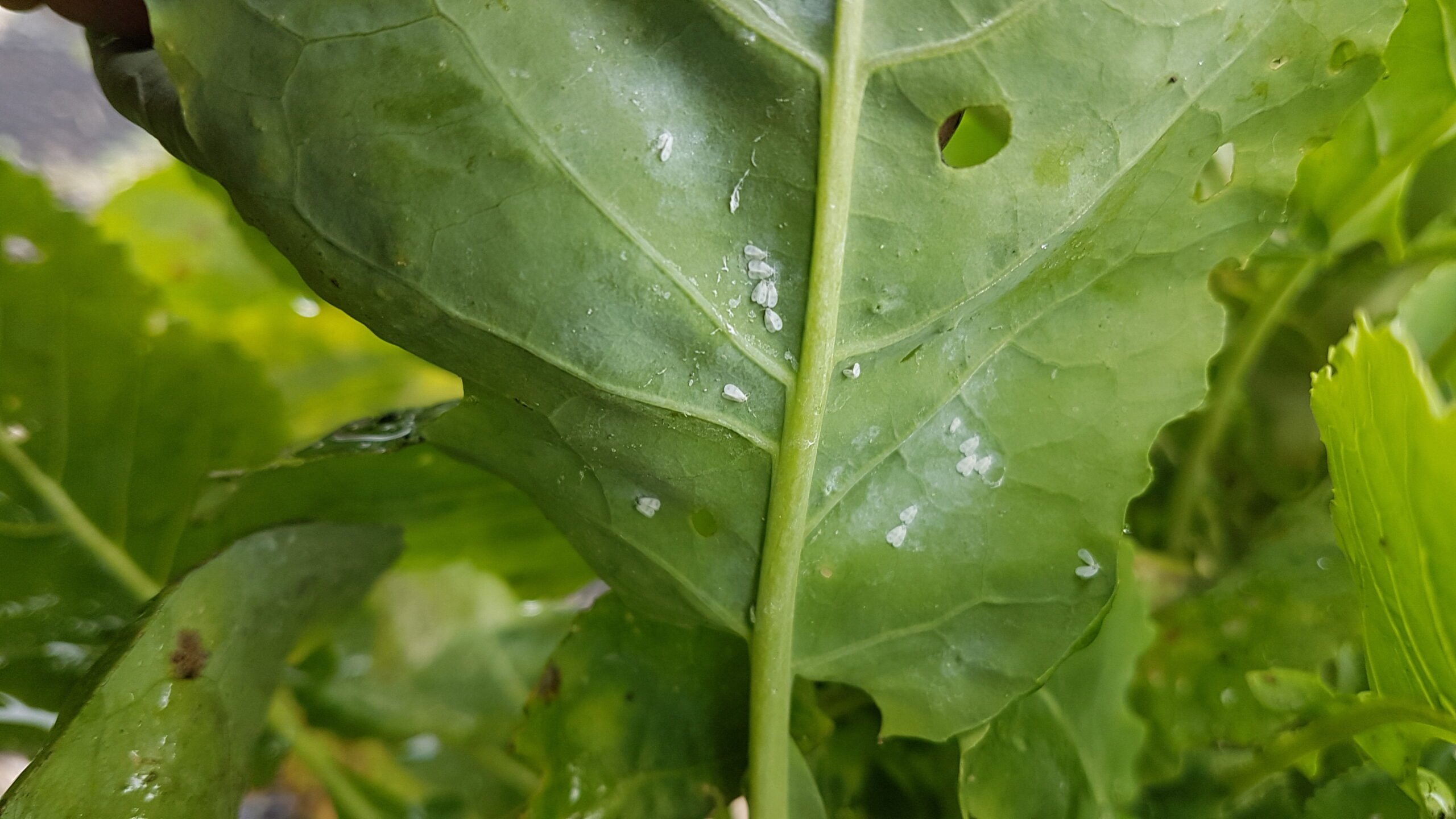
White Fly
Bemisia Tabaci
Pathogène :
Insect
Type:
Risque:
MILD
Mosca blanca



Descrição da doença
Bemisia tabaci, known as the whitefly, is a hemipteran insect of the Aleyrodidae family that affects numerous crops, including chard. This pest has several biotypes, the most common being B and Q. The whitefly goes through several stages of development: egg, four nymphal stages and adult. The yellowish eggs are laid on the underside of the leaves. The nymphs emerge from the eggs and attach themselves to the leaf, where they remain motionless while feeding on plant sap. During the nymphal stages, whiteflies excrete a sugary substance known as honeydew, which promotes the growth of sooty mold fungi. Adults are winged, white and small, allowing them to easily disperse to other plants. Reproduction is rapid and can occur year-round under favorable conditions, making this pest difficult to control.
Descrição do patógeno
In chard, whitefly causes a disease that manifests itself with several symptoms that affect both the aesthetics and health of the plant. The damage is caused mainly by the feeding of the nymphs and adults, which suck the sap, weakening the plant and reducing its vigor. The excreted honeydew can cover the leaves, favoring the growth of sooty mold fungi, which interfere with photosynthesis and deteriorate the quality of the crop. In addition, Bemisia tabaci is a vector of various phytopathogenic viruses that can cause additional diseases.
• Presence of adult whiteflies on the underside of the leaves.
• Chlorotic Taches on the leaves.
• Discoloration and wilting of leaves.
• Reduced growth and general weakening of the plant.
• Presence of sticky honeydew on the leaves.
• Development of sooty mold fungi on the surface of the leaves.
• Transmission of phytopathogenic viruses.
TEMPERATURA E UMIDADE
20ºC - 30ºC
50% - 70%
CAMINHOS DE TRANSMISSÃO</span
Wind, contact between plants, gardening tools, infested plants.
CONTROL
Tratamento químico
• ORANGE OIL 6% [SL] P/V
• ORANGE OIL 60g/L [ME] P/S
• PARAFFIN OIL (CAS [64742-46-7]) 79% [EC] P/V
• PARAFFIN OIL (CAS [8042-47-5]) 54.6% [EW] P/V
• Azadirachtin 2.6% (AS AZADIRACTIN A) [EC] P/V
• DELTAMETHRIN 2.5% [EW] P/V
• LAMBDA CYHALOTHRIN 10% [CS] P/V
• MALTODEXTRIN 47.6% [SL] P/V
• PYRETHRINS 2% (PYRETHRE EXTR.) [EC] P/V
• PYRETHRINS 4% [EC] P/V
• ADHESIVE TRAPS
• CHROMATIC TRAPS
Tratamento biológico
• ORANGE OIL 6% [SL] P/V
• ORANGE OIL 60g/L [ME] P/S
• PARAFFIN OIL (CAS [64742-46-7]) 79% [EC] P/V
• PARAFFIN OIL (CAS [8042-47-5]) 54.6% [EW] P/V
• Azadirachtin 2.6% (AS AZADIRACTIN A) [EC] P/V
• LAMBDA CYHALOTHRIN 10% [CS] P/V
• PYRETHRINS 2% (PYRETHRE EXTR.) [EC] P/V
• PYRETHRINS 4% [EC] P/V
• ADHESIVE TRAPS
• CHROMATIC TRAPS
Traitements biologiques
• AKANTHOMYCES MUSCARIUS (strain Ve6) 14.8%
• AMBLYDROMALUS LIMONICUS
• AMBLYSEIUS SWIRSKII
• BEAUVERIA BASSIANA (STRAIN ATCC 74040) 2.3% (2.3X10E7 VIABLE SPORES/ML) [OD] P/V
• BEAUVERIA BASSIANA (GHA STRAIN) 10.7% (2.26X10E13 CONIDIAS/L) [OD] P/V
• BEAUVERIA BASSIANA (GHA STRAIN) 22% (4.4 x 10E10 CONIDIAS/G) [WP] P/P
• BEAUVERIA BASSIANA strain PPRI 5339 8% (8 X 10E12 CFU/L) [OD] P/P
• CHRYSOPERLA CARNEA
• CORDYCEPS FUMOSOROSEA (strain FE 9901) 18%
• DELPHASTUS CATALINAE
• ENCARSIA FORMOSA
• ERETMOCERUS EREMICUS
• HETERORHABDITIS BACTERIOPHORA
• ISARIA FUMOSOROSEA (Apopka 97 strain) 20% [WG] P/P
• Lecanicillium muscarium (Strain Ve6) (1x10E10 spores/g) 14.8% [WG] P/P
• METARHIZIUM BRUNNEUM strain Ma 43 10.5% [OD] P/V
• PAECILOMYCES FUMOSOROSEUS (STRAIN FE 9901) 18% (2 X 10 E9 CFU/G) [WP] P/P
• TRANSEIUS MONTDORIENSIS
Recomendações
• Carry out frequent monitoring to detect the early presence of the pest.
• Use yellow sticky traps to capture adults and reduce their population.
• Implement cultural practices such as crop rotation and elimination of weeds that can serve as alternative hosts.
• Maintain adequate ventilation and spacing between plants to reduce humidity and the density of the whitefly population.
• Introduce and encourage natural enemies such as parasitoid wasps (Encarsia spp. and Eretmocerus spp.) and predators (ladybugs and lacewings).
• Apply insecticidal soaps and horticultural oils to suffocate nymphs and adults.
• Use chemical insecticides on a rotational basis to avoid the development of resistance, always following local recommendations and good agricultural practices.
• Implement physical barriers such as anti-insect mesh to protect young and vulnerable plants.
TRAITEMENTS
Remèdes maison
There are no home treatments
Alliés naturels
Traitements chimiques
There are no treatments for this disease. Treatments are directed at the insect vectors that transmit it. See insect treatments.
RECOMMANDATIONS
- Check the back of the leaves frequently, especially in dry weather.
- Spray water on the leaves to increase humidity and prevent them from settling.
- Keep plants healthy with good watering and adequate light.
- If you see cobwebs or damage, clean the leaves with a damp cloth or pressurized water.
- Use potassium soap or neem oil every few days until they disappear.
Plantes répulsives
Rosemary, Dill, Coriander
PRODUITS RECOMMANDÉS
*Os tratamentos recomendados ainda são recomendações de acordo com os bancos de dados de autoridades e em nenhum momento substituem as diretrizes estabelecidas de acordo com a legislação de cada país
*Les produits présentés sont des recommandations et ne sont pas nos propres produits. En tant qu'associés Amazon, nous gagnons des revenus grâce aux achats de produits recommandés.





















